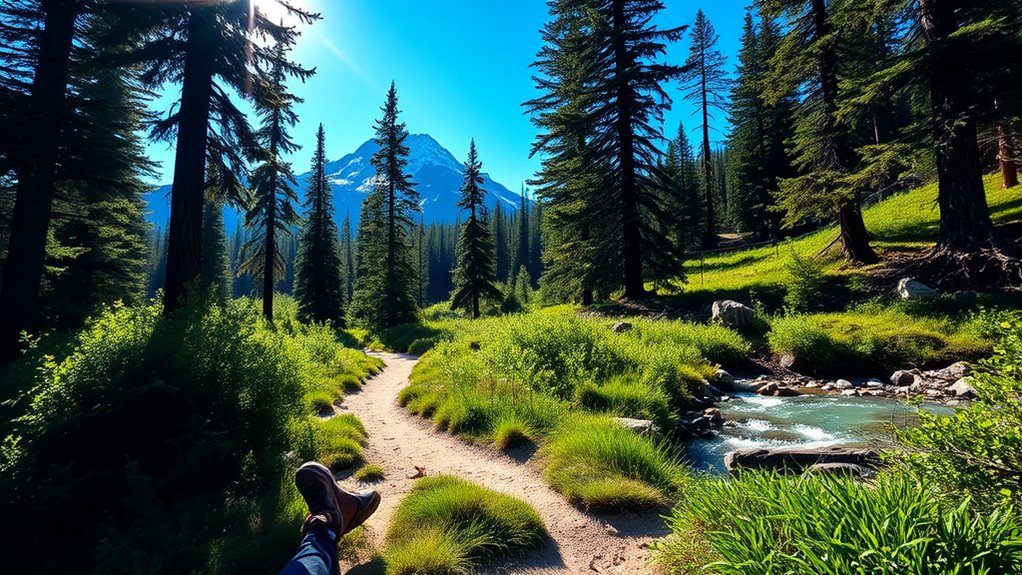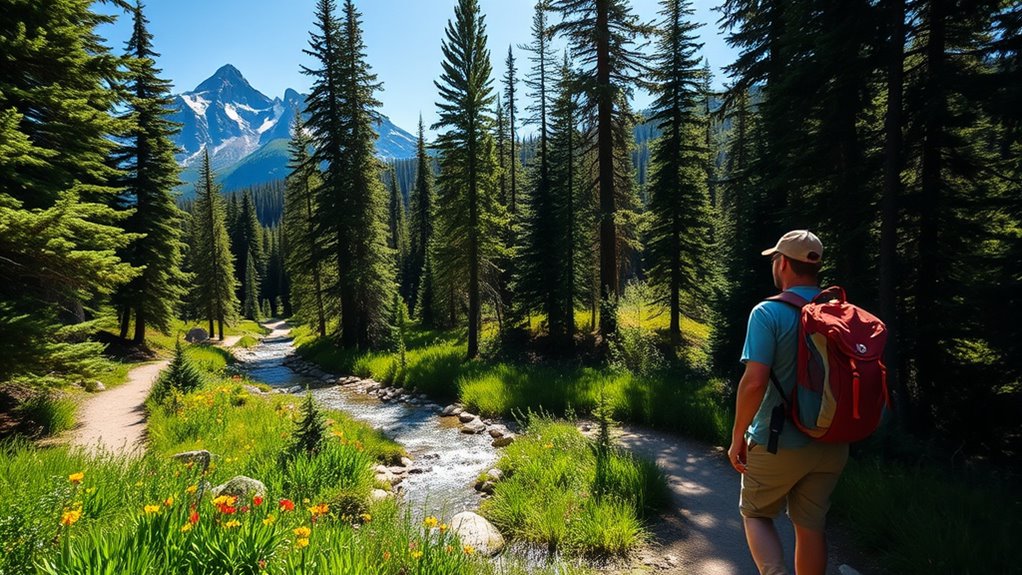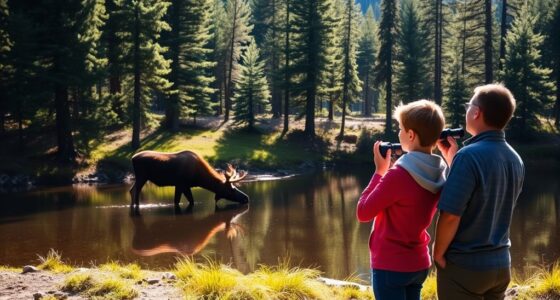Low-impact hiking in Banff National Park means sticking to established trails to prevent erosion and protect delicate plants. Keep your distance from wildlife like elk and grizzly bears to avoid disrupting their natural behaviors. Carry only what you need, using reusable containers to cut down on waste. By hiking during off-peak times, you’ll lessen your impact on trails and wildlife habitats. There’s so much more to discover about preserving this beautiful landscape for future generations.
Key Takeaways
- Stick to established trails to prevent erosion and protect Banff’s delicate ecosystems and scenic beauty.
- Maintain a respectful distance from wildlife to support their natural behaviors and habitats.
- Pack only essentials and use reusable containers to minimize litter and waste on the trails.
- Hike during off-peak times for better wildlife viewing and to reduce trail impact.
- Educate yourself and others about the park’s flora and fauna to promote conservation efforts.

When you venture into Banff National Park, remember that preserving its stunning landscapes starts with low-impact hiking. The breathtaking views, diverse wildlife, and pristine environments are treasures that require your care and respect. By adopting low-impact hiking practices, you’ll help protect these natural wonders for generations to come.
First, make sure you stick to established trails. Wandering off the beaten path can cause erosion, damage delicate plants, and disrupt wildlife habitats. Trail maintenance relies on hikers like you who respect the boundaries set by nature. Following designated trails minimizes your impact and helps maintain the park’s beauty. You’ll enjoy the scenery without contributing to the degradation of the environment.
Stick to established trails to protect the environment, prevent erosion, and help preserve the beauty of Banff National Park.
As you hike, be mindful of the wildlife around you. Banff is home to various species, from elk to grizzly bears, and your actions can greatly affect their habitats. Keep your distance and don’t approach animals, no matter how tempting it may be to snap a picture. Wildlife preservation is essential, and maintaining a respectful distance ensures that animals can thrive in their natural habitats without feeling threatened by human presence.
When packing for your hike, bring only what you need. Carry reusable containers for food and drinks to minimize waste. If you encounter litter, pick it up and dispose of it properly. Every small effort counts towards keeping Banff clean and conserving its stunning landscapes. By practicing these habits, you contribute to a culture of environmental stewardship that encourages others to do the same. Additionally, consider using self-watering pots to care for your plants at home, which can reduce water usage and support sustainable gardening practices.
Also, consider your hiking times. Early morning or late afternoon hikes are often best for wildlife viewing while minimizing disruptions during the day. Avoid hiking during peak times to lessen the impact on both the trails and the animals. Being mindful of your surroundings and the time you choose to hike can make a meaningful difference in wildlife preservation.
Finally, educate yourself about the park’s specific flora and fauna. The more you know, the better equipped you’ll be to protect the environment. Share your knowledge with fellow hikers to foster a community that prioritizes low-impact practices. The beauty of Banff National Park is a shared treasure, and it’s up to each of us to safeguard it through our actions. By embracing low-impact hiking, you’ll not only enjoy the great outdoors but also play a vital role in preserving it for future adventurers.
Frequently Asked Questions
What Are the Best Low-Impact Trails for Beginners in Banff?
For beginners, the best low-impact trails in Banff include the Tunnel Mountain Trail and the Johnson Lake Loop. These trails offer moderate difficulty and are easily accessible, making them perfect for new hikers. You’ll enjoy stunning views without overwhelming your stamina. Remember to wear proper footwear and stay on designated paths to minimize your impact on the environment while you explore the beautiful scenery that Banff has to offer.
Are Dogs Allowed on Low-Impact Hiking Trails in Banff National Park?
Yes, dogs are permitted on some low-impact hiking trails in Banff National Park, but there are specific dog regulations and trail restrictions you need to adhere to. Always keep your dog on a leash, and be mindful of wildlife. Certain trails may have seasonal restrictions, especially during the summer months when wildlife is more active. It’s best to verify the latest guidelines before you head out to ensure a safe and enjoyable hike for you and your dog.
Can I Camp Overnight on Low-Impact Hiking Routes?
Yes, you can camp overnight on low-impact hiking routes, but you’ll need to follow specific camping regulations. Make sure to obtain the necessary overnight permits before setting up camp. These regulations help safeguard the environment and ensure a safe experience for everyone. Always check the latest guidelines from the park authorities, as they can change based on seasonal conditions. Enjoy your adventure while respecting nature!
What Should I Pack for Low-Impact Hikes in Banff?
Sure, you can head out with a snack and flip-flops, but let’s not tempt fate! For low-impact hikes, pack essential gear like sturdy shoes, weather-appropriate clothing, and a first-aid kit. Don’t forget navigation tools like a map and compass—or your phone, if you’re feeling lucky! Hydration’s key, so bring plenty of water too. You want to enjoy nature, not become a cautionary tale, right? Now, get out there and hike smart!
Are There Guided Low-Impact Hiking Tours Available in Banff?
Yes, there are guided tours available in Banff that focus on low-impact hiking. These tours emphasize eco-friendly practices, ensuring you enjoy the stunning scenery while minimizing your environmental footprint. You’ll have the chance to learn about the local ecosystem from knowledgeable guides who prioritize sustainability. By joining a guided tour, you get to explore the beauty of the area responsibly, making the experience even more enriching and enjoyable.
Conclusion
As you lace up your hiking boots in Banff National Park, remember that every step can leave a gentle footprint on this stunning landscape. By practicing low-impact hiking techniques, you not only preserve the beauty of the trails but also guarantee future generations can enjoy them too. So, why not make your next adventure a sustainable one? Embrace the thrill of exploration while protecting the wild—it’s a win-win for both you and the environment!










